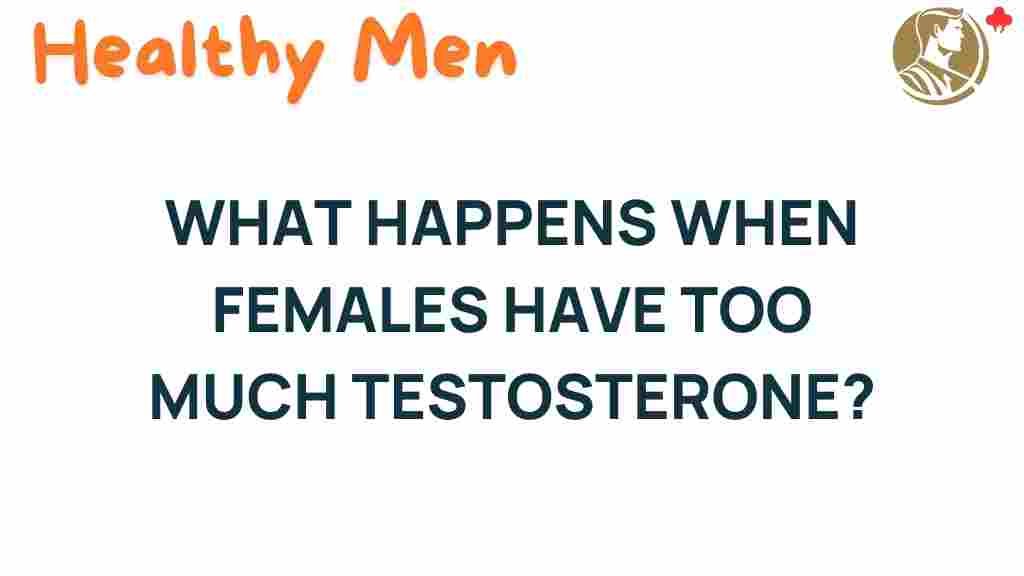Unraveling the Mystery: The Effects of Excess Testosterone in Women
Testosterone is often associated with men, but it plays a crucial role in women’s health as well. While testosterone is necessary for various bodily functions, an excess of this hormone can lead to significant health issues for women. In this article, we will explore the effects of excess testosterone, focusing on hormonal imbalance, symptoms, diagnosis, treatment, and lifestyle adjustments to support well-being.
Understanding Testosterone in Women
Testosterone is a steroid hormone produced in small amounts by the ovaries, adrenal glands, and peripheral tissues in women. It is important for maintaining bone density, muscle strength, and libido. However, when testosterone levels become elevated, it can disrupt the delicate balance of hormones in a woman’s body.
Hormonal Imbalance and Causes
Hormonal imbalance occurs when the levels of hormones in the body are disrupted. In women, excess testosterone can result from several factors, including:
- Polycystic Ovary Syndrome (PCOS)
- Adrenal gland disorders
- Hormonal therapy or medications
- Obesity
- Certain tumors
Understanding these causes is crucial for identifying the source of excess testosterone and addressing the issue effectively.
Symptoms of Excess Testosterone in Women
Women experiencing elevated testosterone levels may notice a range of symptoms that can affect both physical and emotional health. Some of the most common symptoms include:
- Irregular or absent menstrual cycles
- Acne and oily skin
- Increased body hair growth (hirsutism)
- Thinning hair on the scalp
- Weight gain or difficulty losing weight
- Fatigue and mood swings
- Decreased libido
- Sleep disturbances
If you are experiencing any of these symptoms, it is essential to consult a healthcare professional for a thorough evaluation.
Diagnosis of Excess Testosterone
Diagnosing excess testosterone in women involves several steps. Here’s a step-by-step process:
- Medical History Review: Your doctor will take a detailed medical history, including information about your menstrual cycle, weight changes, and any other symptoms you may be experiencing.
- Physical Examination: A physical exam may be conducted to check for signs of excess testosterone, such as hirsutism or acne.
- Blood Tests: Blood tests are crucial for measuring hormone levels, including testosterone, estrogen, and other related hormones.
- Imaging Tests: In some cases, ultrasound or other imaging tests may be ordered to check for ovarian cysts or adrenal tumors.
Once diagnosed, treatment options can be discussed to help manage symptoms and restore hormonal balance.
Treatment Options for Excess Testosterone
Addressing excess testosterone involves a combination of lifestyle changes and medical treatments. Here are some common approaches:
- Medications: Hormonal contraceptives, anti-androgens, and insulin-sensitizing agents are often prescribed to help manage symptoms.
- Weight Management: Maintaining a healthy weight through diet and exercise can significantly impact testosterone levels and overall hormonal balance.
- Cosmetic Treatments: For symptoms like hirsutism, methods such as laser hair removal or electrolysis may be recommended.
- Stress Management: Techniques such as yoga, meditation, or counseling can help reduce stress, which may further stabilize hormone levels.
It’s essential to work closely with a healthcare provider to develop a personalized treatment plan that addresses your specific needs.
Lifestyle Changes for Hormonal Balance
In addition to medical treatments, certain lifestyle changes can help manage excess testosterone and promote overall well-being:
- Balanced Diet: Focus on a diet rich in whole foods, including fruits, vegetables, whole grains, and lean proteins. Avoid processed foods and refined sugars.
- Regular Exercise: Engaging in regular physical activity can help maintain a healthy weight and improve insulin sensitivity.
- Adequate Sleep: Prioritize sleep hygiene to ensure restorative sleep, which is vital for hormonal regulation.
- Avoiding Endocrine Disruptors: Reduce exposure to chemicals found in plastics, personal care products, and pesticides that can interfere with hormonal balance.
Implementing these changes can significantly enhance your health and help manage symptoms associated with excess testosterone.
Troubleshooting Common Issues
Despite your best efforts, you may encounter challenges while managing excess testosterone. Here are some troubleshooting tips:
- Track Your Symptoms: Keep a journal to monitor symptoms, diet, and lifestyle changes. This can help identify triggers and patterns.
- Communicate with Your Doctor: If your treatment plan isn’t effective, don’t hesitate to discuss your concerns with your healthcare provider.
- Seek Support: Join support groups or online communities where you can connect with others facing similar challenges.
- Stay Informed: Educate yourself about hormonal health. Resources such as WomensHealth.gov offer valuable information.
Conclusion
Excess testosterone in women can lead to various health issues, but understanding its effects and addressing the underlying causes can significantly improve quality of life. By recognizing the symptoms, seeking proper diagnosis, and implementing effective treatment and lifestyle changes, women can manage hormonal imbalances successfully. Remember, your health is a priority, and taking the steps to address hormonal issues can pave the way for better overall well-being.
For further reading on women’s health and hormonal balance, consider exploring more resources on hormonal health.
This article is in the category Conditions and created by healthymen Team
